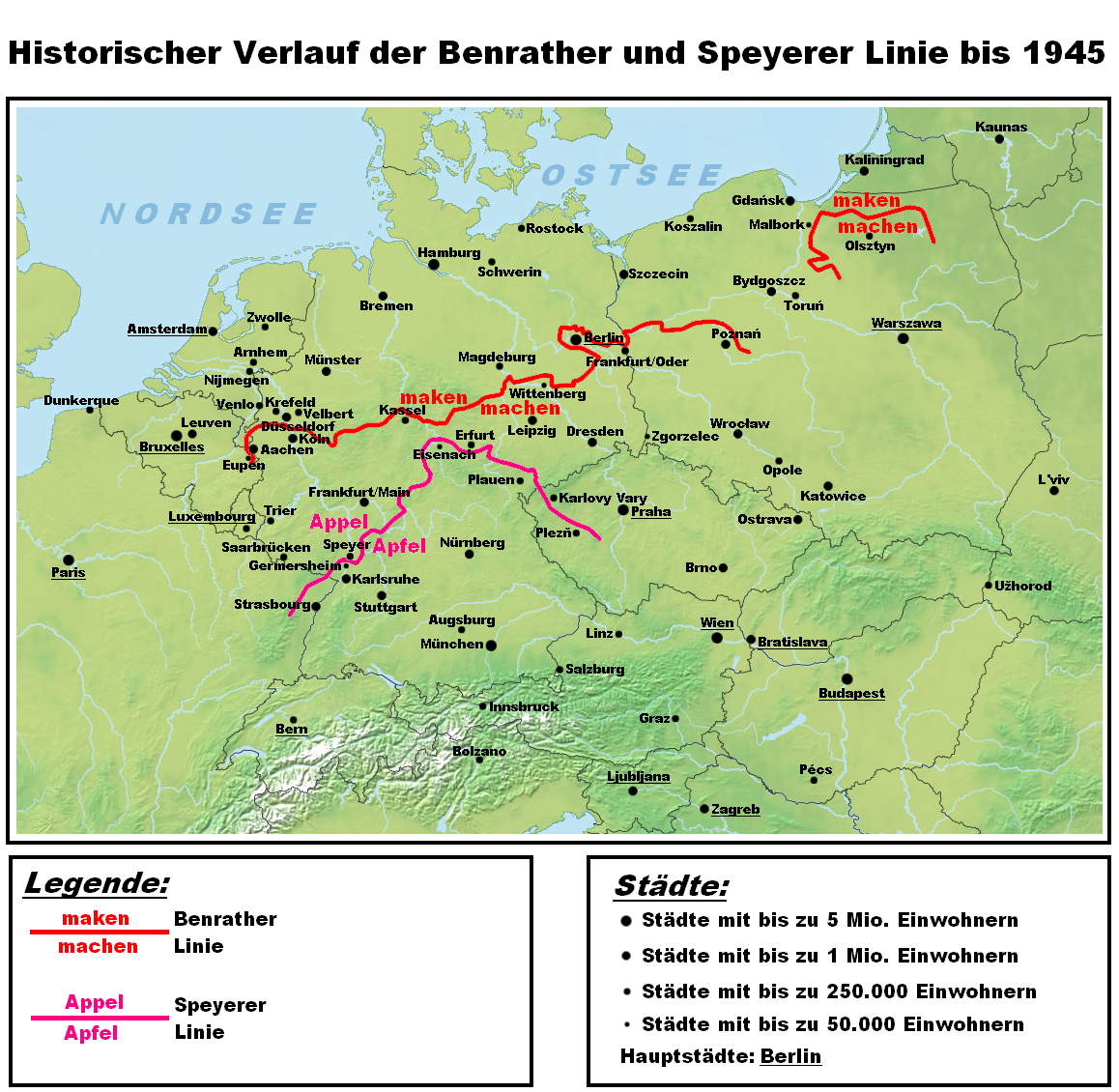Speyer Line on:
[Wikipedia]
[Google]
[Amazon]
 In
In
 In
In German dialectology
German dialects are the various traditional local varieties of the German language. Though varied by region, those of the southern half of Germany beneath the Benrath line are dominated by the geographical spread of the High German consonant s ...
, the Speyer line or Main line (Main
Main may refer to:
Geography
* Main River (disambiguation)
**Most commonly the Main (river) in Germany
* Main, Iran, a village in Fars Province
*"Spanish Main", the Caribbean coasts of mainland Spanish territories in the 16th and 17th centuries
...
River) is an isogloss
An isogloss, also called a heterogloss (see Etymology below), is the geographic boundary of a certain linguistic feature, such as the pronunciation of a vowel, the meaning of a word, or the use of some morphological or syntactic feature. Major d ...
separating the Central German dialect
The term dialect (from Latin , , from the Ancient Greek word , 'discourse', from , 'through' and , 'I speak') can refer to either of two distinctly different types of Linguistics, linguistic phenomena:
One usage refers to a variety (linguisti ...
s to the north, which have a stop
Stop may refer to:
Places
* Stop, Kentucky, an unincorporated community in the United States
* Stop (Rogatica), a village in Rogatica, Republika Srpska, Bosnia and Herzegovina
Facilities
* Bus stop
* Truck stop, a type of rest stop for truck d ...
in words like ''Appel'' "apple", from the Upper German
Upper German (german: Oberdeutsch ) is a family of High German dialects spoken primarily in the southern German-speaking area ().
History
In the Old High German time, only Alemannic and Bairisch are grouped as Upper German. In the Middle High G ...
dialects to the south, which have an affricate
An affricate is a consonant that begins as a stop and releases as a fricative, generally with the same place of articulation (most often coronal). It is often difficult to decide if a stop and fricative form a single phoneme or a consonant pair. ...
: ''Apfel''. The line begins in Alsace near Strasbourg
Strasbourg (, , ; german: Straßburg ; gsw, label=Bas Rhin Alsatian, Strossburi , gsw, label=Haut Rhin Alsatian, Strossburig ) is the prefecture and largest city of the Grand Est region of eastern France and the official seat of the Eu ...
, and runs north-east to Thüringen, crossing the Rhine at Speyer
Speyer (, older spelling ''Speier'', French: ''Spire,'' historical English: ''Spires''; pfl, Schbaija) is a city in Rhineland-Palatinate in Germany with approximately 50,000 inhabitants. Located on the left bank of the river Rhine, Speyer li ...
. After passing close to Erfurt
Erfurt () is the capital and largest city in the Central German state of Thuringia. It is located in the wide valley of the Gera river (progression: ), in the southern part of the Thuringian Basin, north of the Thuringian Forest. It sits i ...
, it turns south-east and continues into the formerly German-speaking parts of Bohemia. The line is exemplified by place-names containing an uncombined /p/ phoneme, which lie north of the line (Paderborn
Paderborn (; Westphalian: ''Patterbuorn'', also ''Paterboärn'') is a city in eastern North Rhine-Westphalia, Germany, capital of the Paderborn district. The name of the city derives from the river Pader and ''Born'', an old German term for t ...
, Potsdam
Potsdam () is the capital and, with around 183,000 inhabitants, largest city of the German state of Brandenburg. It is part of the Berlin/Brandenburg Metropolitan Region. Potsdam sits on the River Havel, a tributary of the Elbe, downstream of B ...
, Wuppertal
Wuppertal (; "''Wupper Dale''") is, with a population of approximately 355,000, the seventh-largest city in North Rhine-Westphalia as well as the 17th-largest city of Germany. It was founded in 1929 by the merger of the cities and to ...
), while those with an affricate /pf/ ( Pfaffenhofen, Pforzheim
Pforzheim () is a city of over 125,000 inhabitants in the federal state of Baden-Württemberg, in the southwest of Germany.
It is known for its jewelry and watch-making industry, and as such has gained the nickname "Goldstadt" ("Golden City") ...
) lie mostly to the south.
See also
* Benrath line *Uerdingen line
The Uerdingen Line (german: Ürdinger Linie, Uerdinger Linie, nl, Uerdinger linie; named after Uerdingen by Georg Wenker) is the isogloss within West Germanic languages that separates dialects which preserve the ''-k'' sound in the first perso ...
* High German consonant shift
References
Isoglosses German language {{Germanic-lang-stub